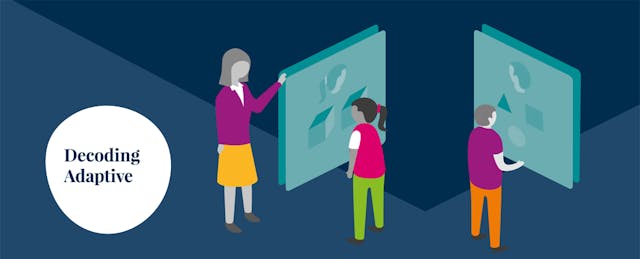When we published “ Disrupting Class” in 2008, we didn’t use the phrase “adaptive learning” once in the book. Just eight years later, it’s nearly impossible to imagine writing a book about educational technology and neglecting the term.
With the rapid growth of blended learning and technology more generally in schools, asking if educational software is capable of adapting to students’ needs is commonplace.
Teachers are increasingly attempting to reach each of their students who have distinct learning needs, at different times, with the right learning experience at the right time. Having effective adaptive software turbocharges those efforts and can provide a realistic pathway to accomplish that goal.
But a critical challenge, as this EdSurge report notes correctly, is to decipher just what that phrase means. A significant percentage of education software companies I talk to use the word “adaptive” almost nonchalantly to describe what they do. Meanwhile, CEOs of some education technology companies snicker that other products on the market aren’t “really adaptive” despite their claims.
In many ways, the field of adaptive learning technology is at the same place K-12 blended learning was in 2010. Back then, leaders of schools implementing blended learning would bicker about which one was “really blended.”
Unless clearly defined, the adaptive learning phrase—which connotes a powerful and important concept—risks becoming meaningless and useless to those who matter most: educators who must evaluate the claims software companies make to serve their students.
Having a definition is critical so that educators and technologists can have a common language through which to communicate about adaptive learning and its potential, not simply talking past each other. A sound underlying taxonomy of the different ways in which products are adaptive can enable educators to ask good questions to find the right software for their particular needs. And a common language will allow educators and technologists to discuss adaptive learning with a depth to build on each other’s ideas and improve the tools, not just talk about how to use existing ones.
To derive such a definition, it takes solid and sober research that is in touch with both the existing literature and the work in the field, so that it has credibility with stakeholders. It must avoid cheerleading—that is, it can’t be normative to suggest that just because something is adaptive, it must be good. Some adaptive tools will be useful, whereas others will be misleading or unhelpful. Because of their vested interests, the individual companies are unlikely to be the ones to define it.
All of this is why EdSurge’s work is so important.
This work represents the first serious and useful definition of what adaptive learning is alongside an accompanying taxonomy to describe how products differ from each other.
This taxonomy will also likely evolve, both as educators and technologists begin to use it to describe what is still a relatively nascent field and the field itself improves. But it offers a starting point to have these critical conversations—and ideally halt much of the miscommunication. And fortunately, because the process to create the definition and taxonomy was robust, it presents a way to continually improve it.
Adaptive learning is an enormously promising field. Educators worldwide are using adaptive tools to change their practice. From Lexia Learning to i-Ready and from Knewton to Smart Sparrow, the tools are growing and gaining acceptance in classrooms. I see adaptive tools in use almost every time I visit schools.
The tools are also not a panacea. For several reasons, it’s unlikely that a single tool will ever be able to take over a student’s education and direct them to every single thing they should do. Nor is it likely that we would want it to, as a critical part of education is building student agency—helping students own their learning, make decisions, become lifelong learners and develop their metacognitive skills. A critical part of education is also developing students’ ability to interact and work with others—from the teachers who guide them and spark their interests and passions to their peers with whom they work, learn and teach. Learning is ultimately a social experience, as it builds people into more mature social actors able to participate in civic society and lead productive lives.
But adaptive learning is a powerful force to make those pursuits more effective and efficient. Additionally, this technology can accelerate our knowledge of what learning experiences work best, for which students, in which circumstances, so that educators can adapt to a reality in which they can help all children find their passions and reach their fullest potential.
This piece was originally published as the forward to EdSurge’s recent in-depth report on Adaptive Learning. To dive deep into the research, you can read the report. If you’d like an overview, you can check out our interactive guide.
Download a PDF of the Adaptive Learning Report


